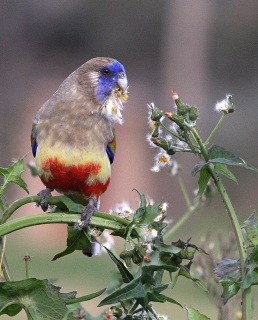Bluebonnet |
|
|
Also known as: Bluebonnet Parrot or Parakeet, Crimson-bellied Parrot or Parakeet, Bulloak Parrot, Oak Parrot, Yellow-vented Bluebonnet (N.h. haematogaster); Red-vented Bluebonnet (N.h. haematorrhous);
Photos
View in GalleryDid You Know?
The incubation time for the Bluebonnet is about 19 days, but a low of 17 days has been recorded. The lowest incubation period of any parrot is 14 days for the Vasa Parrot.Academic Research
Related publications: Northiella haematogasterSpecies Profile
Genus: Northiella | Species: haematogaster
Size:
30cm (11.7 in)
Weight:
65-105g (2.3-3.7 oz)
Subspecies including nominate:
three: N.h. haematogaster, N.h. haematorrhous, N.h. pallescens
Colour Adult:
N.h. haematogaster: Male-olive/grey head and upperparts; lilac/blue face; yellow lower underparts, with varying red patch on abdomen; wing patch yellow/olive. Bill grey/white. Eye dark brown. Female-as in male but with less red on abdomen and duller colours on face.
N.h. haematorrhous: Both adults as in haematogaster, but red patch on abdomen extending to undertail coverts; wing patch brown/red.
N.h. pallescens: Both adults in general much paler than haematogaster; patch on abdomen pale red, minimal or absent in females.
Colour Juvenile:
N.h. haematogaster: As in adult female but duller with little red on abdomen and with slight orange margins to wing patch.
Call:
Calls are harsh and abrupt, emitted irregularly in flight. When alarmed emits a repetitive clucking sound. Also calls a piping whistle when perched. Narethae utters soft, flute-like notes and loud yakking notes.
Listen NowVideo Links:
Video 1More Information:
Content Sources:
CITES
BirdLife International
Cornell Lab of Ornithology/Birds of the World
Parrots: A Guide to Parrots of the World, Juniper and Parr, 1998
ML Media Collection Catalogue 72291, Bluebonnet Northiella haematogaster, Connop, Scott, Victoria, Australia, Nov.22 1993, Cornell Lab of Ornithology. Site
Parrots of the World, Forshaw and Cooper, 1977. 2010 edition
Parrots of the World, Forshaw, 2006.
Parrots in Aviculture, Low, 1992.
Lexicon of Parrots, Thomas Arndt.
Bird Care
Photos
View in GalleryDid You Know?
The incubation time for the Bluebonnet is about 19 days, but a low of 17 days has been recorded. The lowest incubation period of any parrot is 14 days for the Vasa Parrot.Academic Research
Related publications: Northiella haematogasterSpecies Care
Captive Status:
Common in Europe, less so in US and UK.
Longevity:
15+ yrs
Housing:
Walk-in enclosure, minimum length 3m (9.8 ft).
Diet:
Small seed mix such as: canary, millet and smaller amounts of oats, buckwheat, safflower and a little hemp; limited sunflower seed; spray millet; green leaves such as: Swiss chard, lettuce, sowthistle, dandelion, chickweed; seeding grasses; rearing food made from: hardboiled egg and carrot, all ground to crumbly consistency; fruit such as: apple, pear, banana, orange, pomegranate, kiwi, cactus fruits; complete pellet.
Enrichment:
Enjoys bathing, as well as scratching around in sand or soil. Also provide bird-safe, unsprayed flowering branches for chewing, as well as fir, pine or willow branches.
Nest Box Size:
Vertical box 6" x 6" x 16" (15cm x 15cm x 40.6cm)
Clutch Size:
5-6
Incubation Time:
19 days
Fledging Age:
5 weeks
Hatch Weight:
Not recorded.
Peak Weight:
Not recorded.
Weaning Weight:
Not recorded.
Photos
View in GalleryDid You Know?
The incubation time for the Bluebonnet is about 19 days, but a low of 17 days has been recorded. The lowest incubation period of any parrot is 14 days for the Vasa Parrot.Academic Research
Related publications: Northiella haematogasterSpecies Wild Status
World Population:
Unknown, decreasing.
IUCN Red List Status:
Least Concern
CITES Listing:
Appendix II
Threat Summary:
Not globally threatened. Fairly common except at edges of range. Native vegetation clearance in Victoria putting shelter and nest sites at risk.
Range:
N.h. haematogaster: E South Australia, east of Lake Eyre basin and north Flinders Ranges, to NW Victoria, W New South Wales and SW Queensland.
N.h. haematorrhous: Interior of N New South Wales and S Queensland.
N.h. pallescens: Lake Eyre basin and lower Cooper-Strzelecki Creeks drainages in SW Queensland, NE South Australia and NW New South Wales.
Habitat:
Seen in a variety of habitats including open woodland, riverine woodland, remnant mallee Eucalyptus sp. and farmland. In Lake Erye the species is found in open country with scattered trees.
Wild Diet:
Feeds on seeds of herbs, including Atriplex vesicarum, Kochia sedifolia, Bassia and Amaranthus, fruit, berries and acacia blossoms.
Ecology and Behaviour:
Is resident. Are usually seen in pairs or small groups of up to 20 birds. Boisterous and active, this species assembles early to drink and then goes off to feed. The birds feed both on the ground and in trees.
Clutch and Egg Size:
5-6 rounded eggs, 23.5 x 19.5mm (0.9 x 0.7 in)
Breeding Season:
July-December; nest is in tree cavity.
Photos
View in GalleryDid You Know?
The incubation time for the Bluebonnet is about 19 days, but a low of 17 days has been recorded. The lowest incubation period of any parrot is 14 days for the Vasa Parrot.Academic Research
Related publications: Northiella haematogasterMembers Only Resources
Please log-in now to find more research, resources and tools.
Not a Member?
Find more great information:
Gain exclusive access to 600+ pages of additional research, seminars and podcasts, specialists to ask your toughest questions, and dozens of other fun resources - when you become a WPT member.
Join Today >>

































